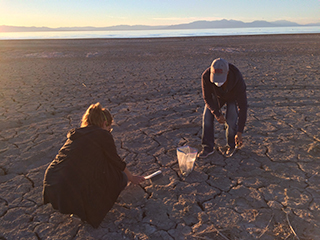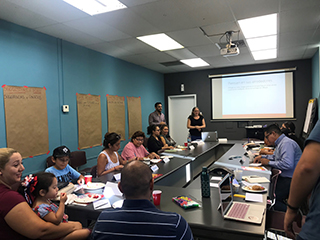Partnerships for Environmental Public Health (PEPH)
Study Location: Los Angeles, California
Academic Partners:
University of Southern California
Shohreh Farzan, Ph.D.
Jill Johnston, Ph.D.
University of Washington
Edmund Seto, Ph.D.
Public Health Institute, California Department of Public Health
Paul English, Ph.D.
Community Partners:
Comité Cívico Del Valle, Inc.
Project Description

Researchers Shohreh Farzan, Ph.D. (left) and Lisa Valencia (right) collect dust samples from the dry lake bed of the Salton Sea.
(Photo courtesy of Shohreh Farzan, Ph.D. and Jill Johnson, Ph.D.)
This project aims to determine the health effects of childhood exposure to particulate matter (PM) and inform public health action in the Imperial Valley of California.
The Salton Sea, a 350-square mile land-locked lake situated in the Imperial Valley, is rapidly shrinking due to changing weather patterns, drought, and increased water demands. It is expected that these conditions may result in desiccation, or drying out, of the Salton Sea, leaving large portions of the lakebed exposed.
An increase in wind-blown dusts from the lakebed potentially containing toxic metals, pesticides, and other harmful particulates could impact the health and quality of life of nearby communities. There is an urgent need to understand how rapid desiccation of the Salton Sea will affect local levels of PM and impact the respiratory health of children in a predominantly low-income, Mexican American community living in the Imperial Valley.

Community partner from CCV, Orangel Olmedo (left), and Shohreh Farzan, Ph.D. (right) at a community health fair where they discussed the AIRE study and the community air monitoring network.
(Photo courtesy of Shohreh Farzan, Ph.D. and Jill Johnson, Ph.D.)
A local community organization, Comité Cívico del Valle (CCV), operates the largest community air monitoring network in the country and is uniquely positioned to quantify wind-blown dust exposures in the Imperial Valley. This project will leverage the CCV air monitoring resource in conjunction with a community-engaged epidemiological approach. The results of the study will be shared with the community to increase environmental health literacy and inform public health actions to reduce wind-blown exposure of PM.

Participants gather for a “Platicas del AIRE” parent meeting to discuss environmental health concerns in Brawley, California.
(Photo courtesy of Shohreh Farzan, Ph.D. and Jill Johnson, Ph.D.)
Specific project aims are to:
- Form a children's respiratory health study through the collaborative development of materials and instruments for public education, parental involvement and health assessments, and report-back of results.
- Quantify children's exposures to PM by leveraging an existing community-based air monitoring network and by developing a source-apportionment model using hallmarks of Salton Sea dust.
- Assess the impacts of chronic insults of PM on longitudinal respiratory health and atopic conditions in 500 elementary school-aged children.
- Build an evidence base to inform the participation of families in decision-making processes on the Salton Sea.
- Establish the Assessing Imperial Valley Respiratory Health and the Environment (AIRE) Community Health Education and Advocacy program to expand the capacity of local institutions and residents to meaningfully address environmental health disparities.


